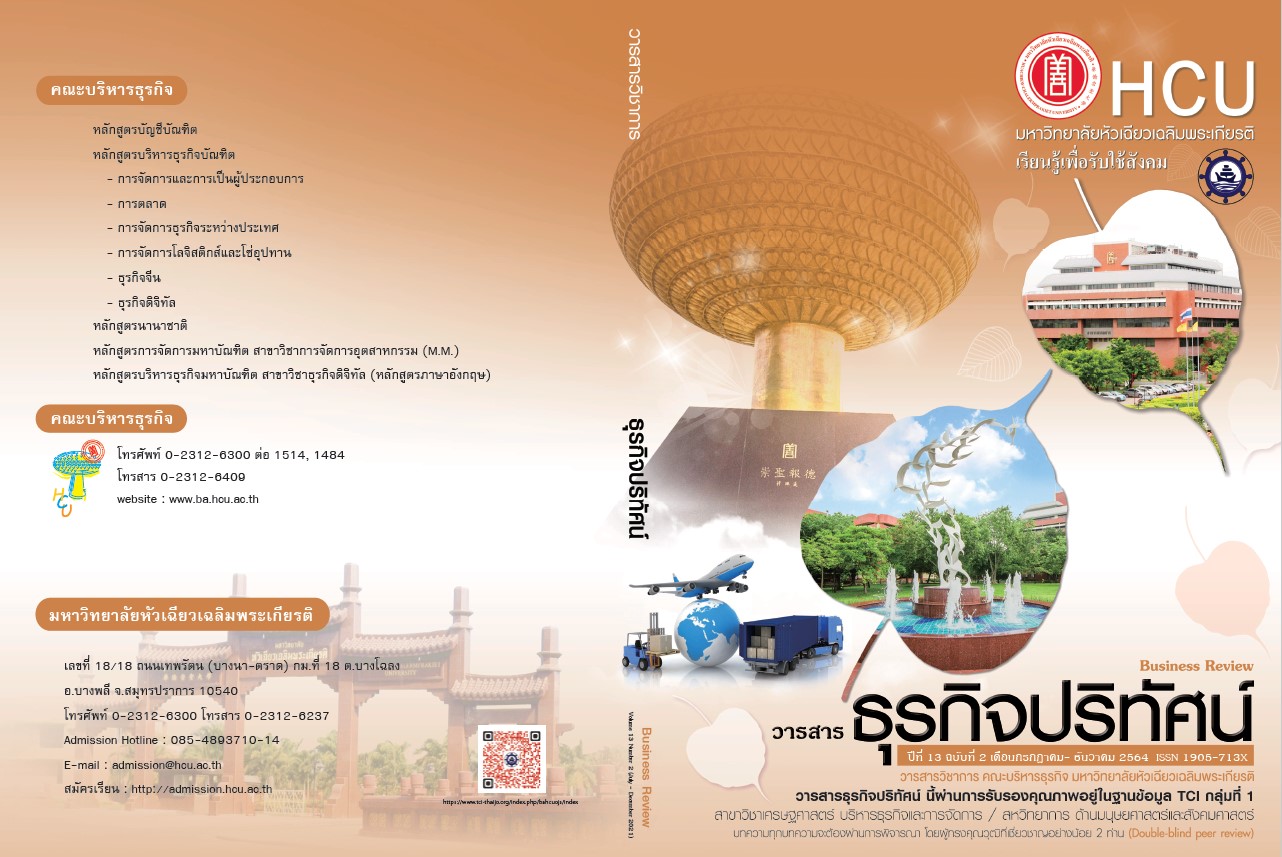Value of Courier Delivery Characteristics Impact to Purchase Intention and Brand Trust
Keywords:
Value of Courier Delivery Characteristics, Purchase Intention, Brand TrustAbstract
The objectives of this research are to study the level of value and impact of courier delivery characteristics on purchase intention and brand trust. The samples of 400 people. The statistic for data analysis was Percentage, Mean, Standard Deviation, and the Structural Equation Model. The result showed that most of samples were bachelor's degree education or higher, and had income under 50,000 THB/month. Level from factor of value of courier delivery characteristics, economically accessible price, trustful relation with courier, operation flexibility and implement of drop-pick up box were high and order visibility is very high. Level of purchase intention and brand trust were high. Structural equation modeling analysis that the model fit into the empirical data (X2/df = 1.750, GFI = 0.961, AGFI = 0.942, NFI = 0.947, RFI = 0.932, IFI = 0.977, TLI = 0.970, CFI = 0.976, RMSEA = 0.430) and found that of value of courier delivery characteristics had positive impact on purchase intention
References
ปิยะกรณ์ สุนทรวัฒน์. (2553). ปัจจัยในการคัดเลือกผู้ประกอบการขนส่งสินค้าอุปโภคบริโภคด้วยรถบรรทุก.วิทยานิพนธ์วิศวกรรมศาสตรมหาบัณฑิต, จุฬาลงกรณ์ มหาวิทยาลัย.
สำนักงานพัฒนาธุรกรรมทางอิเล็กทรอนิกส์. (2563). รายงานผลการสำรวจมูลค่าพาณิชย์อิเล็กทรอนิกส์ในประเทศไทย ปี 2562. กรุงเทพฯ: สำนักยุทธศาสตร์ สำนักงานพัฒนาธุรกรรมทางอิเล็กทรอนิกส์ กระทรวงดิจิทัลเพื่อเศรษฐกิจและสังคม.
Bagozzi, R. P., & Yi, Y. (2012). Specification, evaluation, and interpretation of structural equation models. Journal of the Academy of Marketing Science, 40(1), 8–34.
Daniel, C. (2013). Land Transport. New Centre: Singapore Logistics Association & Straits Times Press.
Deutsch, M. (1958). Trust and Suspicion. Journal of Conflict Resolution, 2, 265-279.
Fulconis, F., Nollet, J., & Paché, G. (2016). Purchasing of logistical services: a new view of LSPs’ proactive strategies. European Business Review, 28(4), 449-466.
Ghajargar, M., Zenezini, G., & Montanaro, T. (2016). Home delivery services: innovations and emerging needs. IFAC-PapersOnLine, 49(12), 1371-1376.
Grabner-Kraeuter, S. (2002). The role of consumers' trust in online-shopping. Journal of Business Ethics, 39(1-2), 43-50.
Hahn, K. H., & Kim, J. (2009). The effect of offline brand trust and perceived internet confidence on online shopping intention in the integrated multi‐channel context. International Journal of Retail & Distribution Management, 37(2), 126-141.
Hair, J. F., Black, W. C., Babin, B. J., Anderson, R. E., & Tatham, R. L. (1998). Multivariate data analysis (5th ed.). London: Prentice-Hall International Inc.
Holter, A. R., Grant, D. B., Ritchie, J., & Shaw, N. (2008). A framework for purchasing transport services in small and medium size enterprises. International Journal of Physical Distribution & Logistics Management, 18, 21-38.
Hu, L.-t., & Bentle, P. M. (1999). Cutoff criteria for fit indexes in covariance structure analysis: Conventional criteria versus new alternatives. Structural Equation Modeling, 6(1), 1–55.
Huang, C. C. (2017). The impacts of brand experiences on brand loyalty: Mediators of brand love and trust. Management Decision, 55(5), 915-934.
Hübner, A., Kuhn, H., & Wollenburg, J. (2016). Last mile fulfilment and distribution in omni-channel grocery retailing: A strategicplanning framework. International Journal of Retail & Distribution Management, 44(3), 228-247.
Kenning, P. (2008). The influence of general trust and specific trust on buying behaviour. International Journal of Retail & Distribution Management, 36(6), 461-476.
Kundu, S., & Datta, S. K. (2015). Impact of trust on the relationship of e-service quality and customer satisfaction. EuroMed Journal of Business, 10(1), 21-46.
Lim, S. F. W. T., Jin, X., & Srai, J. S. (2018). Consumer-driven e-commerce: A literature review, design framework, and research agenda on last-mile logistics models. International Journal of Retail & Distribution Management, 44(3), 228-247.
Marquardt, A. J., Golicic, S. L., & Davis, D. F. (2011). B2B services branding in the logistics services industry. Journal of Services Marketing, 25(1), 47-57.
Pan, S., Giannikas, V., Han, Y., Grover-Silva, E., & Qiao, B. (2017). Using customer-related data to enhance e-grocery home delivery. Industrial Management & Data Systems, 117(9), 1917-1933.
Punakivi, M., & Saranen, J. (2001). Identifying the success factors in e-grocery home delivery. International Journal of Retail & Distribution Management, 29(4), 156-163.
Ronald, H. B. (2004). Business logistics/Supply Chain Management (5th ed.). New Jersey: Pearson Prentice Hall.
Schumacker, R. E., & Lomax, R. G. (2010). A beginner's guide to structural equation modeling (3rd ed.). New York: Taylor & Francis Group.
Stevenson, M., & Spring, M. (2007). Flexibility from a supply chain perspective: definition and review. International journal of operations & production management, 27(7), 685-713.
Thamizhvanan, A., & Xavier, M. J. (2013). Determinants of customers' online purchase intention: An empirical study in India. Journal of Indian Business Research, 5(1), 17-32.
Palaima, T., & Auruškevičienė, V. (2007). Modeling relationship quality in the parcel delivery services market. Baltic Journal of Management, 2(1), 37-54.
Zebra Technology. (2018). The Future of Fulfillment Vision Study. Retrieved December 26, 2019, from Zebra Website: https://www.zebra.com/content/dam/zebra_new_ia/en-us/solutions-verticals/vertical-solutions/retail/vision-study/fulfillment-vision-study-report-en-us.pdf
Zenezini, G., Lagorio, A., Pinto, R., Marco, A. D., & Golini, R. (2018). The collection and Delivery Points Implementation Process from the Courier Express and Parcel Operator’s Perspective. Italy: University of Bergamo.
Downloads
Published
How to Cite
Issue
Section
License
All articles published in the Business Administration and Management Journal Review are copyrighted by the journal.
The views and opinions expressed in each article are solely those of the individual authors and do not represent those of Huachiew Chalermprakiet University or any other faculty members. Each author is fully responsible for the content of their own article. Any errors or issues found are the sole responsibility of the respective author.




